|
WHITBOURNE and other
earlier adventurers who visited Newfoundland, speak in high terms of the
productiveness of the soil. As early as 1610 John Gay, who had
established a colony in Mosquitto, in Conception Bay, speaks of the
climate not being so severe as in England; he also raised garden
vegetables. In 1623, Governor Wynn in his communications to Sir George
Calvert, from Ferryland, speaks of wheat, barley, and oats being eared
on the 17th of August, and that the garden vegetables had arrived at
perfection.
Sir Richard Bonnycastle
says :—
“Whitbourne was
ridiculed when he talked of the productiveness of Newfoundland, and Lord
Baltimore was almost ruined by choosing to build his castle on a bleak
and desolate part of the coast, instead of upon the western shores, or
in the interior. Had he chosen the fine healthy climate of St. George’s
Bay, or the Bay of Islands, for the seat of the Calverts, Newfoundland
would now have possessed a capital, rivalling that he afterwards founded
in the pestiverous swamps of Maryland, and which, by dint of
perseverance and labour, has since risen to rank as the fourth city of
the Union, notwithstanding its ancient insalubrity. Alas ! its
capabilities have never been truly appreciated; they interfered with the
certain gains derivable from the Bank fishery; a false policy prevented
the settlement of the fairest half of the Island, superior to parts of
the opposite continent; and this has continued until nearly the present
moment, because Great Britain was unnecessarily generous to the
conquered French, and because it was originally the open and undisguised
policy of a few rich merchants to keep tlie trade limited to the Bank
fishery, thereby ensuring wealth to them at home, and to those they
employed in the island as their chief factors.’
Again, Sir Richard
says:—
“The climate is less
severe on the western side of Newfoundland, the land more rich, in
consequence of limestone prevailing there; and it is now known to be
quite as capable of cultivation as Nova Scotia, Cape Breton or Prince
Edward Island. It is therefore to that portion that we must hereafter
look as the seat of a population dependant upon an inexhaustible field
of agricultural resources. But with all its natural advantages in the
scale, we must not allow it the whole weight; for assuredly the eastern
half of Newfoundland is cultivable to the extent of supporting a
population which can be gradually thrown into it, either for the
fishery, or for settlement; and, at this day, notwithstanding the
constant fog of misstatement which has been so sedulously cast over it,
there is no colony of England which can produce a better fed, a
healthier, a better clothed, or a more industrious and better behaved
population, than the fisherman settlers and natives of Newfoundland.”
The first settlers in
nearly all the British Colonies were aided by the Imperial Government to
cultivate the land, whereas not a single shilling had ever been expended
on Newfoundland, either for cultivation or any other improvement.
Mr. Morris says :—
“The ancient British
Colonies were aided, if not by the Government, by the capital, skill,
and industry of private parties, in their progress towards settlement
and colonization. It was for the modern Colonies that the munificence, I
may say the profusion, of Government was reserved.
“In 1748, the parent
government commenced the colonization of Nova Scotia, advertised for
settlers—large grants of land were offered—and also means for its
cultivation, and subsistence until the land made returns. For that
purpose 3,760 adventurers with their families were entered for
embarkation according to the order of the Board of Trade. Application
having been made to Parliament, £40,000 were voted to defray the
expenses of their removal, ‘the liberality of this grant enabling
Government to make ample provision for their comfort and support.’ They
set sail in the beginning of May, 1749, under the command of the
Honourable Edward Cornwallis, whom the King had appointed their
Governor, and towards the latter end of June arrived at Chibucto Harbour
(now Halifax), the place of their destination. At that time the whole of
the country bordering on Chibucto was covered by woods to the water’s
edge. The cold and sterile soil on both sides of the harbour was clothed
with the beautiful verdure of the spruce and fir, whose umbrageous limbs
concealed the rocks that were scattered in profusion on its surface, and
which were doomed to disappoint the hopes and defeat the labour of the
inexperienced settlers. As they passed up the harbour they noticed
several canoes tilled with savages, who approached within a convenient
distance, to observe the motions of the strangers; and then fled with
inconceivable rapidity.—Haliburton’s Histvry, vol. I, page 138.
“In 1750 and 1751,
Government induced by great encouragement a number of German Protestants
to emigrate to Nova Scotia. In these years near 2,000 persons embarked
at Rotterdam, and were settled down at Lunenburg, now a populous
thriving settlement. In seven years, from 1748 to 1755, the sum of
£445,584 14s. 11d„ was expended in the new settlement. Mr. Burke had
some reason to exclaim, in his speech in 1780, on economical reform:
‘The Province of Nova Scotia was the youngest and the favourite child of
the Board. What sums the nursing of that ill-thriven, hard-visaged, and
ill-favoured brat has cost to this mttol nation. Sir, this Colony has
stood us in a sum not less than seven hundred thousand pounds. To this
day it has made no repayment, it does not even support those offices of
expense which are miscalled its Government. The whole of that job lies
upon the patient, callous shoulders of the people of England.’
“It cost England
upwards of a million for the colonization of Nova Scotia.
“The cost for the
colonization, protection, and settlement of the Canadas, goes beyond
counting. It may be stated by tens of millions, without reference to the
vast expenditure at an earlier period. Some idea may be formed of the
facilities for settlement and colonization in Canada, from the following
summary of vast recent public improvements in Canada, taken from a
statement of Sir Francis Bond Head.
“Magnificent harbours
have been fortified, valuable fisheries and timber trade established,
and mines in operation. On macadamised roads upwards of two hundred
thousand pounds have already been expended, also an immense sum in plank
roads.
On the Rideau Canal
upwards of a million; on the Welland Canal half a million; on the St.
Lawrence Canal more than three hundred thousand pounds ; on the Lachine
about one hundred thousand, besides large sums on the Grand River
navigation, lay navigation, innumerable mills of various descriptions
have been constructed ; lastly, and in addition to the above, a million
and a half sterling, the loan from the mother country, either has been
expended or is at this moment expending on public works and improvements
of various descriptions.” Sir F. B. Head’s Emigrant, page 86.
“About the year 1806,
the late Dr. William Carson arrived in Newfoundland; he at once saw the
great injustice that was done, both to the country and the resident
inhabitants, by the sertii barbarous policy that prevailed which
prohibited the cultivation of the soil. He raised his voice against it,
wrote some excellent tracts on the subject, denounced it in the
strongest terms, incurring no small risk of being transported for his
temerity for arraigning the Venerable system that had prevailed for
centuries. He became the most strenuous advocate for the cultivation of
the soil, which he represented as fully equal in quality to that of his
native country, Scotland; he was opposed by the local authorities, by
the merchants, and a great portion of the inhabitants; he was ridiculed
as a visionary. Notwithstanding, in good report and in evil report, he
persevered until he saw, for some time before his death, his views and
doctrines almost unanimously approved of by all parties. Dr. Carson may
be called the parent of agriculture of Newfoundland; he not only
eneouraged it by precept, but likewise by example. In the year 1818 or
1819, he obtained a large grant of waste land from the then Governor Sir
Charles Hamilton, which he cleared and cultivated at considerable labour
and expense. The land cleared and cultivated by Dr. Carson forms one of
the most valuable farms in the vicinity of St. John’s.
“Though Dr. Carson,
like most such proprietors, men who devote themselves to the public
service, may not have gained by his agricultural speculations, however,
his efforts for the improvement of the soil were eminently successful.”
In the year 1827 or
1828, during the government of Sir Thomas Cochrane, one of the principal
merchants of St. John’s, H. P. Thomas, Esq., obtained a grant of 250
acres of waste land, distant some four miles from the town of St.
John’s, which he cleared and cultivated, and occupied for some years,
until he was repaid for the whole expense of the outlay; he then let the
ground on lease to an intelligent Scotch farmer (the same person who had
the superintendence of it from the beginning) at a rent of £200 sterling
per annum, who in a few years, some twelve or fourteen, after paying his
rent, realized a sum of not less the <£4,000. Twenty years before, this
land was a wilderness, not producing one shilling a year, unapproachable
even by a footpath. Since that time numerous farms have been cleared,
many miles beyond it. I may say with truth, that within a circuit of two
or three miles from this farm, there are now some thousands of acres in
profitable cultivation, and in the occupation of some hundreds of
industrious families.
On the arrival of Sir
Thomas Cochrane as Governor of Newfoundland in 1825, he became the
advocate of agriculture, opened a line of road from St. John’s to
Portugal Cove, and Cochrane Street, in front of Government House. He
also cultivated lands surrounding his private residence, “Virginia
Waters,” situated about three miles from the town. During the
administration of Captain Prescott, in 1838, 1839, about $175,000 was
voted by the Legislature for opening up roads, and the Governor gave
some hundreds of pounds from his private purse to assist Mr. Currie, a
Scotch farmer, to cultivate a small farm.
On the arrival of Sir
John Harvey, the Governor in 1841, he endeavoured to dispel the
prejudice which had existed for centuries against the cultivation of the
soil. On the 13th of January, 1842, an Agricultural Society was formed
under his patronage. The following is an extract from the speech of Sir
John, delivered on the occasion:—
“Newfoundland is in
reality something more than a mere ‘fishing station,’ and possesses
resources beyond the mere ‘ rocks on which to (liy the nets of tlie
fishermen ; ’ in a word, I saw in it the undoubted evidence of a
capability for agricultural pursuits far beyond what I had imagined to
exist; and I likewise saw that by no other means can the great staple of
this island, its fisheries, and the great national objects, the nursery
of seamen and the consumption of the manufactures of the parent state,
be so effectually promoted as by bringing the homes of the fishermen
nearer to the scene of their pursuits and operations; in a word by
encouraging settlement and the cultivation of the soil—an encouragement
which contemplates the rapid increase of its population, consequently of
its fishermen and mariners as well as of brave, hardy, loyal, and
permanent settlers, who would constitute the ‘ constitutional defence ’
of the colony, and whose labours as auxiliary to the fisheries, might,
at no remote period, go far to render the island independent of all
foreign countries for the means of feeding those engaged in them.
“Without entering into
speculations regarding a subject with which we are as yet imperfectly
acquainted, but upon which it will be the duty of the Executive
Government, through the aid of the Provincial Legislature, to acquire
more accurate information—I mean the adaptation or otherwise of the
extensive prairies of the interior of the island for cultivation and
settlement—it may be sufficient for my present purpose merely to advert
to a fact which is within the knowledge of you all, viz., that this
island, throughout almost the whole extent of its bays, harbours and
inlets, is skirted by a belt of cultivable land, varying in depth fix mi
one to several leagues, well calculated to reward the labour of the
agriculturist—of which no more convincing proof can be required than the
specimens of produce now before you, consisting of wheat, barley, oats,
turnips, potatoes, &c., equal in size, in weight, and in quality *o the
productions of any other country, England not excepted.
“It may be asked
(elsewhere) ‘how is this to be explained ’vith reference to the reputed
sterility of the soil of Newfoundland, and to the length and severity of
its winters and the consequent shortness of its open seasons.’ The
answer is, ‘by the productive qualities of that soil, to which the
imputation of sterility so unjustly attaches; by the fineness of its
autumnal season, which affords ample opportunity for the preparation of
the ground for the spring crops; and by the almost unexampled rapidity
of vegetation during the summer, by which the shortness of that season
is amply compensated.”
The following is also
an extract of a speech delivered by Sir John Harvey at a ploughing match
in 1844.
“Almost from the first
moment of my arrival in this island, my eyes were opened to the fact of
which the inhabitants themselves evidently appeared not to be
sufficiently aware, viz., that it possessed agricultural treasures,
capabilities, and advantages, as well of soil as of climate, which, if
not unequalled, are yet certainly not surpassed by any of the
surrounding colonies. And, as the result of three years’ experience, I
will now read to you a short extract from a despatch which I have very
recently addressed to Lord Stanley, and in which it has been my
endeavour, in the discharge of my duty, to place before his Lordship my
impressions upon a subject of so much importance to its inhabitants as
the capability of the soil of a colony which has heretofore been
regarded as little more than a mere fishing station, to minister to the
wants, to the comforts, and even to the profit of those engaged in the
prosecution of the fisheries. After speaking in the despatch referred to
of the increased value which must necessarily be conferred upon lands by
the construction of good and practicable roads in all colonies in which
the soil is cultivable, I have said, ‘ With respect to this island
(hitherto undervalued, as it appears to me to have been), there can be
no doubt that the whole of those tracts designated (and depreciated by
that designation) by the appellation of ‘barrens’ (merely because
denuded of trees), are among the most fertile and productive soils in
British America, the sections almost everywhere presenting to the eye
from four to six feet of fine, light, gravelly soil, capable of
producing luxuriantly every species of crop, except, perhaps, wheat, and
requiring only the aid of artificial manures, and careful and judicious
culture, to give good returns even in that species of grain, while in
respect to all others, more especially grasses of every kind, including
clover, vetches, and, I will add, flax, in oats and barley, turnips,
potatoes, and in fact every species of “green crop,” I have seen no
country out of England and Egypt superior to it.’”
The opening of good
roads has greatly increased the value of land. In 1844 lands were sold,
in their primeval state, at public auction, at from $2 to $16 per acre.
These lands were situate on the Bay Bulls road, five or six miles from
the Town of St. John’s. There is no loam in Newfoundland. The soil on
the eastern shores, for the most part, consists of fine gravel,
interspersed occasionally with marl. The geological structure of this
part of the coast is composed of the secondary rocks, comprising shale
and gritstone, variegated slates, and sandstones. On the western portion
of the island the soil is superior. In St. George’s Bay and Bay of
Islands the coal field is situate. Marbles, limestone and soft sandstone
also abound. In 1846 I procured three samples of the virgin soil from
different parts of the neighbourhood of St. John’s.
The following is an
analysis of one sample obtained near the Convent, which was made by Dr.
Stabb, and given in a paper which he read before the Agricultural
Society:—
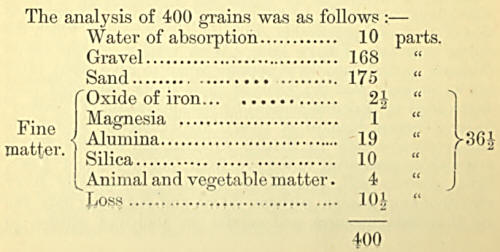
“In all cases,” said
Sir Humphry Davy, “the constituent parts of the soil, which tenacity and
coherence are the finely divided matters. A small quantity of finely
divided matter is sufficient to fit a soil for the production of turnips
and barley.”
“The soil analysed
contained a fair proportion of fine matter, and the gravel and sand
combined with it were aluminous. Upon the whole, therefore, the St.
John’s slate soil is of an aluminous nature, deficient in animal and
vegetable matter, and wanting the essential ingredient—lime.
“It is consequently
necessary to add the lime, and afterwards to maintain a regular supply
of animal and vegetable manure. To apply lime, as a component earth, it
must not be simply added in the state of burned lime, just sufficient to
aid the decomposition of peat, or of animal and vegetable substances in
general, as at the first formation of the manure heap—although highly
useful in this way,—but it must be separately ploughed into the soil.
“I think it expedient
to caution farmers against the practice of burning the surface of our
soil, for it is only useful when there is an excess of vegetable matter;
whereas the slate rock is deficient in this ingredient”
On the arrival of
Governor Sir John Gaspard Le Marchant, in 1847, he at once devoted his
attention to the cultivation of the soil, and promoted agriculture in
every way. It is said that in 1841 a considerable quantity of wheat was
grown in Newfoundland.
The following is an
extract from the report of the Agricultural Society of Newfoundland for
1848, of which Charles Simms, Esq., was president:—
“The Farmers’ Mill, at
the River Head, St. John’s, has been set in operation, partly by the
liberal aid of his Excellency the Governor, and partly by subscription;
and although its power at present is scarcely equal to the numerous
demands for the grinding of corn, means are being taken, by the erection
of new and improved machinery, which will give the mill a greatly
increased power.
“The Society has
observed with regret that that valuable implement—the plough,
indispensable as it is in the cultivation of the soil to any
considerable extent, has been hitherto little used, and indeed almost
unknown, not only in many of the out districts, but even in some of the
more distant parts of this district; and under these circumstances it is
gratifying to observe that his Excellency the Governor, in order to
stimulate to an increased cultivation of the soil, has caused some
efficient one-horse ploughs to be placed in several of the outports,
which have of course been found of the greatest utility in the saving of
labour; and from the number of horses which are entirely idle in the
summer time in most of the out districts, an extensive use of the plough
in place of manual labour would be quite practicable at little expense,
and would be most beneficial in promoting the cultivation of the soil.
The Society hopes that persons in the out districts will not be slow in
obtaining so valuable an acquisition to assist their farming operations
when they find that a plough will turn as much ground in one day as a
man will require a fortnight or three weeks to dig.
“The prizes of a
handsome silver cup and premiums of money, which His Excellency so
liberally offered to the most successful grower of grain crops, have
given rise to a very extensive and spirited competition amongst the
farmers and other cultivators of the soil, and have been highly useful
in exciting increased attention to that all-important branch of
agriculture.
“The following is a
list of prizes given by His Excellency, to encourage the growth of corn,
with the names of the successful competitors :—
"The Le Marchant Cup—‘
for the greatest breadth of wheat crops, fair marketable quality for two
consecutive years ’—to Hon. Patrick Morris.
“For the best crop of
wheat, on any land of not less extent than three acres, £6—to Mr.
Michael Allen.
“For the best crop of
wheat, on any land of not less extent than two acres, £4—to Mr. William
Hext, Grove Farm. u For the best cultivated crop of wheat, on any land
of not less extent than one acre, £3—to Mr. John Harding, White Hills.
For the best cultivated crop of wheat, on any land of not less extent
than half an acre, £2—Mr. James Shea, hear Bally Hally.
“For the best
cultivated crop of oats, on any land of not less extent than two acres,
£3—to Mr. John Dwyer, Oaks Farm. “ For the best crop of wheat, of not
less than half an acre in Outer Cove, £2—to Daniel Griffin.
“For the second best
crop of wheat in Outer Cove of not less than half an acre, £1—to Patrick
Roach.
“For the best crop of
wheat in Torbay, of not less extent than half an acre, £2—to-White.
“For the second best
crop of wheat in Torbay, of not less extent than half an acre, £1—to
Thomas Costello.
“The judges of the
crops, Messrs. Thomas Duder, James Gibson, David Reed, and Thomas Walsh,
are all persons of great practical experience as farmers, and their
examination required several days to accomplish. They close their report
by stating that they found the numerous crops they visited, in general
well cultivated, and that they far exceeded in number and extent of
ground what they had expected. His Excellency has also intimated an
intention to give prizes of an increased amount for competition next
year, a list of which it is intended to append to this report.
“The importation which
His Excellency has made of a bull and cow of the Ayrshire breed, will,
it is hoped, be of ultimate utility, although it has not hitherto been
the practice to breed and rear cattle in this district, principally
owing to the large quantity of lean cattle imported from Prince Edward
Island and Nova Scotia. Those persons, however, who had bred and reared
cattle in the neighbourhood of St. John’s, as well as in other parts of
the colony, agree in the opinion that cattle bred in this Island are
much hardier, and better suited to the country than those imported. In
the south and west parts of this colony, large numbers of cattle are
bred and reared, and in the district of Placentia and St. Mary’s alone,
there are nearly 2,000 head of horned cattle kept, and about 800 in the
district of Burin, and these numbers may not be considered the average
stock constantly on hand. Hence it is obvious that if due attention were
paid to the improvement of the breed, and if a system of agriculture
were introduced and applied in those places where cattle are kept
extensively, great advantages would arise, as well to the individuals as
to the colony, in a much larger amount of produce. The completion of one
of the roads to Placentia would also be a great and most desirable aid
in furtherance of these objects, by enabling cattle to be driven to St.
John’s at all seasons, especially early in the spring, when meat is
scarce and dear, and before importations commence from the neighbouring
colonies. The premium which His Excellency the Governor has recently
offered to encourage a better system of stall-feeding cattle will, it
may be confidently expected, awaken attention to the object, and tend to
an improved practice in that department of our agriculture.
“The Agricultural
Society would desire to impress upon the minds of all, and especially of
those who rely on their own industry, and their own labour for support,
the importance of an active and zealous attention to the cultivation of
the soil as the foundation of their comfort and their independence. Let
them break up and bring into cultivation all the waste land which their
means and their ability will enable them, especially when it is in the
vicinity of their dwellings or other convenient locality.”
The following is an
extract from the Petition of the House of Assembly in 1837, to Her
Majesty the Queen, on the subject of the Crown Lands :—
“It is only within the
last twenty years that general permission has been given to the
inhabitants to cultivate the soil of Newfoundland. It will scarcely be
believed at this happy era of your Majesty’s accession to the throne of
your ancestors, when the people in the most distant parts of your
extensive empire look forward with unbounded confidence and hope to the
just, mild, and merciful Government of your Majesty, that for upwards of
two centuries the cultivation of the soil in Newfound-land was
considered a criminal offence, and prohibited under the severest
restrictions and prohibitions; this withering and desolating policy was
the cause why your Majesty’s Colony of Newfoundland did not improve in
the same progress with the other colonies in its neighbourhood.
“Representations have
been made from the earliest period to the present Government, that the
extreme severity of the climate, and the sterility of the soil of
Newfoundland, formed insurmountable obstacles to cultivation. If these
representations are correct, the House of Assembly would humbly submit
to your Majesty, that there can be no necessity for creating further
obstacles beyond those raised by nature herself.
“But may it please your
Majesty, these were false representations made by persons, who, from
corrupt or interested motives of their own, attempted to arrest the
order of Providence, and prevent the people of Newfoundland from
receiving that support and sustenance from the soil which God and nature
intended it to afford.
“The House of Assembly
therefore have most humbly to bring the subject under your Majesty’s
benign consideration, with the certain hope that your Majesty will be
graciously pleased to give every encouragement, and remove every
restriction to the cultivation of the soil of your Majesty’s ancient and
loyal colony of Newfoundland.”
Gypsum, of which there
is abundance on the west coast of Newfoundland, could be procured at a
small cost, and would make an excellent top-dressing for the meadow
lands. Fish offal and sea-weed are used throughout Newfoundland as
manure. It is calculated that nearly one-half the weight of the fish
taken is thrown away in heads and entrails into the sea. Manufactures
for the conversion of fish offal into a concentrated manure are now in
operation in the United States. The French, too, on the French shore, on
the northern part of Newfoundland (Quirpon), have a manufactory of the
same sort, and export the product to France.
Mr. Morris says :—
“It may be said that
landed property quadrupled in value during the eminently successful
Government of Sir John Harvey. The most important measure of Sir John
Harvey’s Government in reference to the agricultural improvement of
Newfoundland is the law for the sale and regulation of the Crown Lands.
“Her Majesty consented,
and with a truly royal bounty, to grant the whole of the land to her
loyal subjects in the colony.
“Newfoundland is no
longer to be hoarded as a *royal wilderness.’ The people will ever
entertain a grateful sense of Her Majesty’s royal beneficence. It is
only those acquainted with the partial mode of disposing of land which
prevailed in Prince Edward Island, and in most others of the modern
North American colonies, that can form a correct estimate of the vast
boon that has been conferred.
“The main principles
affirmed by the Land Act:
“1st—That all lands
should be sold at public auction, subject to a moderate upset price.
“2nd—That not more than
100 acres should be put up in one lot.
“3rd—That public notice
shall be given by the publication in the newspapers of all land sales.
“4th—That all persons
in the occupation of land without grants from the Crown, should be
confirmed in their titles and occupation.
“5th—That the proceeds
of all sales of land shall be paid into the public treasury, to be
appropriated for the internal improvement of the colony.
“The best practical
proof of the capabilities of the soil of Newfoundland for agricultural
purposes, is to be found in the census returns of 1836 and 1845.
“Returns for 1836.
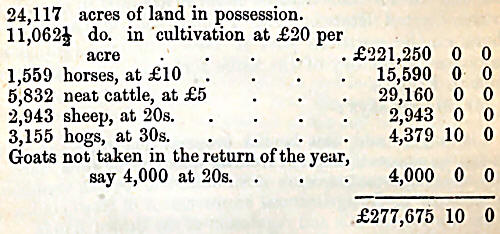
“Annual Produce.


“Returns for 1845.
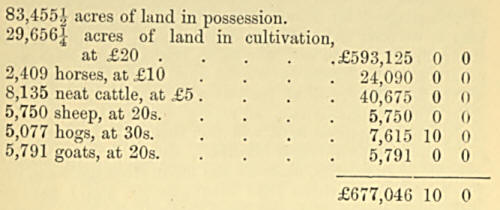
“Annual Produce.

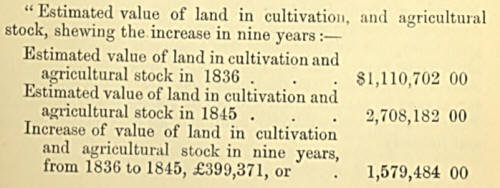

Owing to some errors in
the agricultural returns in 1845, Mr. Morris says that the value of the
produce of that year ought to be $933,319.
Bishop Mullock says :—
“Wheftt will ripen very
well, especially if the proper variety of seed adapted for a northern
country be procured; but as long as we have the great grain country of
the United States at our doors, no one will take much trouble about such
an unprofitable crop. I have never seen finer barley than the growth of
Newfoundland, and all persons who have bought, as I have done,
Newfoundland oats, at nearly double the price of the husky grain
imported here, will find that he has gained by his purchase. Hops are
most luxuriant, and so are strawberries, currants, gooseberries,
cherries, and many other species of fruit. The hawthorn flourishes here
when planted, and I have seen as fine hedges of it laden with haws here
as in the home country ; and I mention this as a proof of the
comparative mildness of our climate, for I find in Russia, as far south
as Moscow, it is a hot-house plant. My estimate then of the agricultural
capabilities of Newfoundland, comparing it with what I have seen in the
north of Europe, is that if we had a large agricultural population we
could support them in comfort, and that as population increases we must
attend more to the land, then more general wealth and comfort will be
diffused a hundredfold than now, when our population is, I may say,
wholly maritime, and we depend almost altogether on other countries for
our food. My earnest advice would be, kill the dogs, introduce settlers,
encourage domestic manufactures, home made linen, and homespun cloth,
and Newfoundland will become the paradise of the industrious man. The
soil in general is thin, but kind, easily cleared, and, beside the
legitimate manure of the farm-yard, can always be enriched near the sea
by sea-ruck and fish offal. The climate is comparatively mild, and all
we want are hands and industry.”
The Local Government
gives an annual grant of $500 in aid of the Agricultural Society. The
following is an extract from the Report of 1849, when Lawrence O’Brien,
Esq., was President:—
“Since the failure of
the potato crop, and during the continuance of the disease, the
attention of the farmers has been naturally turned to the cultivation of
grain, and it is gratifying to observe, that with very few exceptions,
the result has been satisfactory both in yield and quality, the quantity
of barley and oats, independent of wheat, grown, and addressed at the
Farmers’ Mill, River Head alone, during the autumn, and still coming in
daily, sufficiently demonstrates the important fact that the culture of
our corn is no longer confined to a scanty green crop, to help in
feeding cattle, but now results in the production of a primary article
of human food. Our wheat is found to weigh, with few exceptions, not
less than sixty pounds to the bushel, and our oats and barley maintain a
proportionate character. With a view to encourage this important branch
of our agriculture, His Excellency has caused several thousand bushels
of seed corn, of the best and most suitable description, to be imported
from various places, and distributed among the farmers throughout the
colony. The result has been highly advantageous; the harvest has yielded
a fair return, and due care has been taken to mark and ascertain the
varieties of seed, which appear to be best suited to our soil and
climate.
“The Society thankfully
acknowledge the solicitude manifested by the Governor, that the breed of
cattle here should be improved and encouraged. With this view His
Excellency has imported two cows and a bull of the Ayrshire breed. The
bull has been placed at the Grove Farm, in the care of Mr. Jocelyn. Of
the character of the Ayrshire cow it is unnecessary to say more than
that the one imported yields now, without having bestowed on it any more
care or trouble than upon the ordinary cattle, almost double the
quantity of milk that can be obtained from the ordinary cow of the
colony.
“The prizes offered for
competition by His Excellency last season, produced a show of fat cattle
in the Park fronting Government House, in March last, such as never had
been witnessed here before, and would not have disgraced the English
market.
His Excellency in
person handed over the prizes, to the successful competitors, and in
doing so stated, that he should feel happy in giving similar prizes for
the next year. The shew of fat cattle for the ensuing year comes off on
the 12th of March next.
Those prizes, also,
which His Excellency so liberally offered and paid to those, who by
their skill and industry, had reclaimed and brought under cultivation
the greatest quantity of ground, and for the best and most approved
samples of grain of various kinds, and of vegetables, butter and cheese,
have been attended with the happiest results. The exhibition which was
held in October last, in the great hall of the Market House Building, in
competition for those prizes, excited the wonder and astonishment of
many who had been present at exhibitions in the old countries, and who a
few years ago could not be induced to believe that our soil was capable
of yielding such fine samples. The Hall on this occasion was tastefully
decorated with flags and evergreens, the Band of the Royal Newfoundland
Companies was, through the courtesy of the Commanding Officer, in
attendance, and His Excellency, as on former occasions, handed the
several prizes with suitable and encouraging observations to each of the
successful competitors. His Excellency has been pleased to offer an
additional prize of ten pounds for the ensuing years, to be called ‘The
Le Marchant Fiize.’ With a view that no part of our population who may
be industriously inclined may want useful and profitable employment, His
Excellency has taken measures to import and secure the services of a man
and his wife to instruct those who may be desirous to learn the
operation of spinning and weaving flax and wool. The Society strongly
recommend the attention of the labouring classes to this important
branch of industry ; it is one universally pursued throughout tlie
neighbouring colonies; it is well known that one pound weight of wool
will produce one yard of good warm cloth, and of much better texture
than is usually purchased in the shops; and as the expense in producing
it is scarcely anything beyond the time, which in too many instances is
unprofitably spent, it is hoped that the homespun of Newfoundland will
soon become as generally known and valued as the other productions of
the country. The Society begs that those who have not witnessed the
operation of cloth making will satisfy themselves by visiting the St.
John’s Factory where they will witness, and be gratified by, the
proficiency already attained in this domestic manufaeture. Should this
measure succeed, as there is good reason to think it will—it will serve
as a further inducement to pay more attention to the breed and increase
of sheep, which would prove of great advantage.
“It is highly
gratifying to see enrolled among the members of the Agricultural
Society, the names of so' many of the respectable merchants of this
place, who have been spending their lives in pursuing the trade and
fisheries ; it affords the strongest evidence of the fallacy of the
opinions formerly prevalent, but of late years rapidly disappearing,
that to encourage agriculture and promote the cultivation of the soil,
would necessarily create separate and conflicting interests. The facts
already prove the contrary, for not only are the ordinary pursuits of
the fisheries not impeded or in anywise interfered with, but it has now
become evident that the best interests of the trade, and the moral and
social condition of the people, are equally promoted by bringing to our
aid all those valuable auxiliary resources, which, by a proper
application of our skill and industry our soil is capable of yielding to
us, and the Society would now impress upon the minds of all the working
classes, more particularly on those engaged in agricultural pursuits,
that the present state and condition of the country requires that
everyone should renew, and if possible redouble his exertions in his
respective position; and experience abundantly proves, that men capable
of labour, relying under Providence on their own perseverance and
industry, and having such facilities as are so easily attained in
Newfoundland, will seldom fail in procuring a comfortable support and
maintenance for themselves and their families.
"It is a source of
great satisfaction to observe that the disease affecting our potato
crops, has during this season assumed a more mitigated aspect, and has
been much less destructive in its ravages, it is still however more or
less extensive, but we indulge the hope, that by the blessing of
Providence, and a careful attention to the culture of the root, it may
soon pass away. It behoves us in the meantime to bestow every care in
the culture of our ‘corn, and, to apportion the various seeds to the
different soils best fitted for their reception.”
It will be perceived
from the foregoing report of the Agricultural Society, that the
manufacture of “ home spun,” has been commenced in Newfoundland, which
will be of great advantage to the inhabitants. The Island has more
resources than either Nova Scotia or New Brunswick, or even
Massachusetts. There is no reason why manufactures could not be carried
on in Newfoundland, as well as in Massachusetts, the manufactures of
which annually amounted to sixty-two millions of dollars. The population
of Massachusetts for an area of 11,000 square miles is over a million,
while Newfoundland with an area of 36,000 square miles has about 160,000
inhabitants. Flax in Newfoundland grows as well as in any country in the
world, and there is nothing whatever to prevent the manufacture of linen
as well as cotton fabrics. There is plenty of capital, all that is
therefore wanting, is enterprise to put in motion the loom and spindles.
The following returns
made in 1857 will show the increasing value of the agricultural
resources of Newfoundland :—
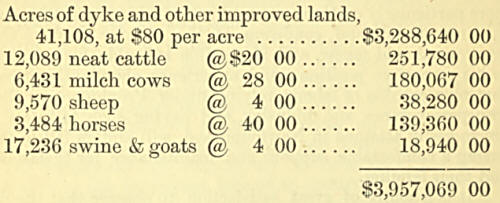


FRENCH SHORE, NORTH AND
WEST
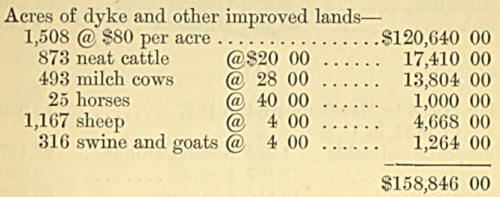
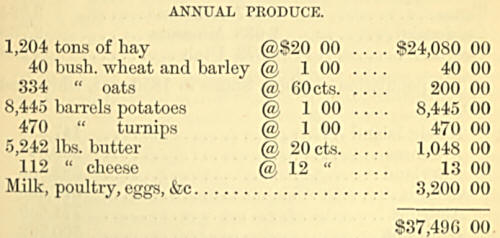

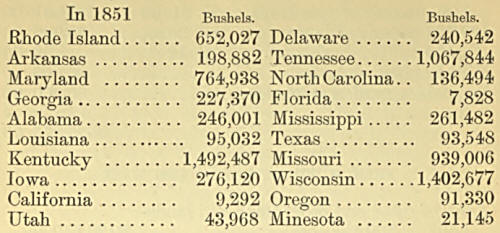
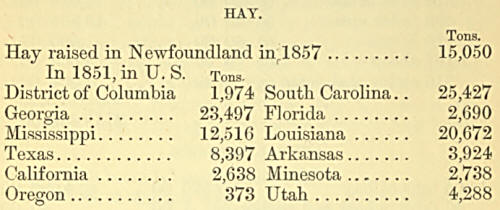
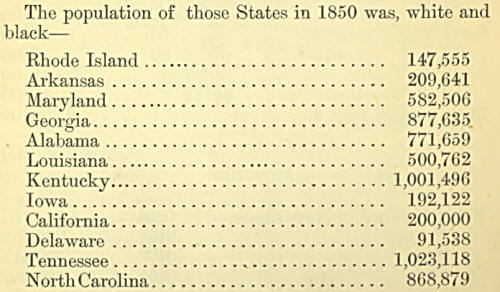

It thus appears that
Newfoundland produces according to population, six times as much
potatoes and hay as some of the above States of the United States. In
1866, the Legislature of Newfoundland passed an Act, giving a small
bounty, as an encouragement to cultivate and settle on the wild lands.
Manufactures according
to the Returns of 1857.— There were in St. John’s, one oil factory,
employing twenty hands, value of oil SI6,080. Logy Bay, one cod-liver
oil manufactory, producing ten tuns of oil, valued at S3,688. Middle
Cove, one cod-liver oil factory, producing five tuns of oil, valued at
SI,156. There were at Torbay three cod-liver oil factories, producing
thirteen and a half tuns of refined and five tuns of common oil and fat;
and at Pouch Cove, three cod-liver oil factories producing twenty-eight
tuns of refined and seven tuns < >f common oil, the whole valued at
$16,104. There were, also, three cod-liver oil manufactories at Petty
Harbour, quantity and value not specified. In St. John’s there was one
foundry, employing seven hands, value of castings $6,540.
There were three
breweries and distilleries, employing thirteen hands, distilling 16,000
gallons of malt liquor and 10,000 gallons of distilled liquor. The
following are the aggregate returns for the whole island:—Fourteen saw
mills, valued at $22,800; three grist mills; boots and shoes
manufactured, $34,714; cabinet ware, $130 ; carts and carnages, $392;
wooden ware, $24,976; lime burnt, 16,500 bushels; butter manufactured,
129,726 lbs.; cheese, 600 lbs.; value of agricultural implements,
$1,200; oil clothing, $2,700; home-spun cloth, 500 yards; soap, 10,000
lbs.; candles, 500 lbs.; stockings and gloves 500 pairs.
The return for 1869
gives the land under culture, 41,715 acres. Yield of crops—turnips,
17,000 bushels; potatoes, 308,357 bushels; hay, 20,458 tons. Butter
made, 168,508 lbs. Horses, 3,764 ; horned cattle, 13,721; sheep, 23,044;
goats, 6,417, and swine, 19,081. The manufactures amounted in value to
$72,675. |
